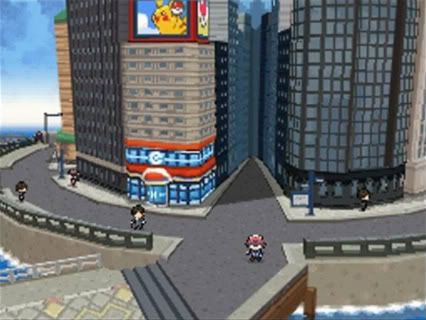
- Format: DS/DSi
- Unleashed: Out Now
- Publisher: Nintendo
- Developer: Game Freak
- Players: 1 (2+ Wi-Fi/IR Trading/Battling)
- Site: http://www.pokemonblackwhite.com/en-us
It’s been some time since the original Japanese release of the first generation of Pokemon games back in 1996. Game Freak, presumably realizing just what age people who have followed from then have got to, sought a rebirth of sorts for the long running franchise. With that in mind, the fifth generation of everyone’s favourite tribute to the slavery of innocent animals is here in Black and White flavour.
Taking place in a location far from any of the previous games, players take up the role of a new male or female trainer starting their adventure in the Unova Region. Following the usual routine, the new trainer aims to gather eight Gym Badges to then allow them to enter the Pokémon League and attempt to defeat the current champion.

I can never decide.
Thrown into the mix is the mysterious N and Team Plasma – a group aggressively stealing Pokemon in order to set them free. Somewhere along the line in production Game Freak probably realized that Team Plasma’s goal of setting Pokemon free from their enforced prisons sounded like too noble an intention and lazily jammed in theft or machinations of world domination (that never really make sense) just so they don’t look like the good guys. Regardless, we came away still believing they were 100% right and accepting that we were in fact playing as the villain.
In keeping with Game Freak’s urge to attract new fans to the genre, the fifth generation features a full 151 new Pokémon and only starts introducing previous generations after the main story has been completed. This means fan favourites found in the wild or even transferred over from your previous games will need to wait until you’ve invested upwards of thirty hours into the game.
This fact may disappoint long time fans with an established team that they prefer to run with during each game’s adventure, and weight is added to this by how poorly designed most of the new Pokémon are. After over 650 individual creatures it’s no surprise that ideas are running a bit thin; but the (frankly stupid) look to most of them is very off putting.
 Where being restricted to a totally fresh set of creatures is a big bonus is the element of surprise to new and old players alike. When you see the name of the next Pokémon a trainer is sending out to battle or that you randomly encounter, you don’t instantly know their weaknesses or their probable abilities. Once you do learn them however the joy of mystery does quickly vanish when you realise that despite new looking creatures, new moves and new evolutions to discover, they all basically follow the same elemental archetypes from previous generations. You can call it a Pidove or a Roggenrola, but to us they might as well be Pidgey and Geodude.
Where being restricted to a totally fresh set of creatures is a big bonus is the element of surprise to new and old players alike. When you see the name of the next Pokémon a trainer is sending out to battle or that you randomly encounter, you don’t instantly know their weaknesses or their probable abilities. Once you do learn them however the joy of mystery does quickly vanish when you realise that despite new looking creatures, new moves and new evolutions to discover, they all basically follow the same elemental archetypes from previous generations. You can call it a Pidove or a Roggenrola, but to us they might as well be Pidgey and Geodude.
That said the game has seen a general brush up in the graphics department. There are many areas where the camera will move with you and pan around to give you as decent a view as the DS is capable of as well as moderate upgrades to battle movement and animation. Overall it’s a very aesthetic change, but welcomed all the same. Locations are a little more varied and lively as well, including a modern Tokyo-style city. An in-built seasons mechanic also means that, played over a long period of time, people will see a change in look to most of the region and even which wild Pokémon might appear.
Despite the new animations, battles remain largely unchanged. There are three-on-three options in multiplayer, and one or two times during the story you can fight with a team of three on a rotating board that you can shift at the start of every turn.
 A rather large problem with the battle system is that you will be seeing a lot of it. For the previous two generations or so the random encounters when exploring saw a sharp rise – and the fifth Generation has taken it a step further. The random encounter rate is ridiculously, sadistically high this time around. It adds an air of frustration to simply trying to get around unheard of in any of the previous games. This is especially true if you run out of items which help you repel encounters for a set number of steps. This is perhaps best summed up with one occasion where our trainer took four single steps in a standard section of grass and was greeted by four battles.
A rather large problem with the battle system is that you will be seeing a lot of it. For the previous two generations or so the random encounters when exploring saw a sharp rise – and the fifth Generation has taken it a step further. The random encounter rate is ridiculously, sadistically high this time around. It adds an air of frustration to simply trying to get around unheard of in any of the previous games. This is especially true if you run out of items which help you repel encounters for a set number of steps. This is perhaps best summed up with one occasion where our trainer took four single steps in a standard section of grass and was greeted by four battles.
A constantly present online mode called C-Gear opens up some new options in three different flavours (though it can be switched off). The Infra-Red mode allows you to ‘tag’ other nearby players to find out more about their progress as a trainer, and the Wireless option grants the options previously only accessible within Pokémon Centres.
The final option is used to connect to Nintendo Wi-Fi through either the Entralink system, Global Trade or Global Link. The Global Link only goes active on March 30th and as such could not be tested for this review, but offers a Global Battle Union and a Pokémon Dream World linked to a membership based official website.
To those who were hoping for something greater than the same game yet again, this generation will be largely disappointing. The increased focus on multiplayer options is welcomed, as is the visual upgrades and general tweaks; but what isn’t welcomed is going through the same trudge yet again, feeling like the villain, with a brutal random encounter rate that makes exploration irritating. For the compulsive collector that just has to catch them all there is probably little to dissuade them from facing these problems and still enjoying themselves, but for everyone else it might be time to move on.



















Comments